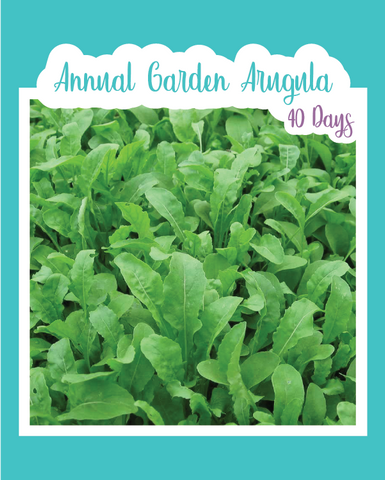
Roquette Arugula (Diplotaxis Tenuifolia)
Seed Count: Approx. 300 seeds
Days to Maturity: 35 Days
Description: Roquette Arugula, also known as Perennial Wall Rocket, (Diplotaxis Tenuifolia) is a member of the brassica family, and is often used fresh in salads to add a peppery, spicy kick. The entire arugula plant is edible, from its leaves, to its flowers and seeds. The flowers have a mild arugula taste and are great for adding color to salads; the seeds are great to make oil with. Use younger greens in your salads. It can also be used to make pesto. Personally I don't like fresh arugula, but I love it cooked along with other greens, like mustard, swiss chard, watercress, and kale, sauteed or "wilted" in butter with onions, and garlic. Its high in vitamin A and C, as well as iron, so it's definitely worth adding to your diet. This green, along with others are best grown as a cool weather crop, and can easily be sown in containers in smaller gardens.
How To Grow
Sowing: After the danger of spring frost has passed, direct sow arugula in full sun, about 1/4 an inch deep and 3-6 inches apart. Arugula can also be sown in partial shade, which may be best in areas with intense sun. For a continuous crop, sow more seeds every 2 weeks, until the heat of the summer starts to roll in. Arugula is best planted as a spring crop or a fall crop, since heat increases the bitterness of the leaves, and can cause the plant to bolt prematurely. Arugula grows well in containers, or in cold frames and green houses during the winter. I always grow mine indoors to reduce the bitterness, since I live in a zone 10b.
Growing: Arugula can tolerate light frosts, but if a hard frost threatens, plants will need protection. Plants should also be protected from extreme heat. Keep plants well watered, and mulch in order to discourage weeds, and conserve moisture. Companion plant arugula with bush beans, beets, carrots, celery, cucumber, dill, lettuce, mint, nasturtium, onion, potato, rosemary, spinach, and thyme; However, avoid planting them with strawberries. Aphids and flea beetles are a common pest for this plant.
Harvesting: Arugula leaves can be harvested about 2-3 weeks, after you sow the seeds, when they reach about 2-3 inches long. Make sure to harvest outer leaves first, if you wish for the plant to continue growing. The entire plant can be harvested at any point, or individual leaves can be taken for a continuous harvest. Mature leaves, which tend to be stronger in flavor, often taste best cooked. Avoid using leaves that have begun to turn yellow, as these have passed their prime. Once cut, greens keep in the refrigerator for 4-5 days. They also freeze well when blanched. Once the plant flowers, the leaves will be too bitter to eat, however, you can harvest the flowers to add to your salads. To save seeds, allow the plants to flower and develop seed pods. Watch the seed pods closely, because once mature they will burst open. I tend to cover my seed pods to avoid seeds scattering around my garden. Thresh seeds out of their pods, spread them out, and allow them to fully dry. Once dry, store them for up to four years.

